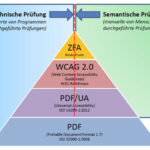 In this article you will find useful tips and instructions on how to create accessible PDF documents.
In this article you will find useful tips and instructions on how to create accessible PDF documents.
The following points should be noted when creating accessible PDF documents:
Structural Information
A PDF document can also contain structural information (tags). For example, headings can be marked, which in turn is useful for a blind user who reads the document with a screen reader.
But using tags alone is not enough, they also have to be set correctly and above all sensibly. The tag structure must be in a logical order. The main tags are:
- Headings
- Paragraphs
- Lists
Logical Reading Order
The reading order in the PDF document must be correct. This is not always the case, especially with multi-column documents: some documents are not read out column by column, but line by line using a screen reader.
Bookmarks
Bookmarks in a PDF document make navigation easier and provide more clarity. Again, it is important that the bookmarks are arranged logically and logically (this should make it possible to jump to specific sections in the document).
Searchable Text
A document that consists of scanned text images is inherently inaccessible because the content of the document is a graphic that represents the letters on the page, non-searchable text. Assistive technology software cannot read or extract the words in a graphical representation.
Alternative Text
As in HTML, images can also be described alternatively in PDF documents. These alternative texts are read out by the screen reader.
Voice Awards
The main language can be defined in a PDF document. In addition, sections and even individual words with different languages can also be defined within the document. These readings can be recognized by screen readers and the language is changed automatically.
Quality Checks
An initial automatic check recognizes various formal defects. Such can e.g. with the freely available PDF Accessibility Checker (PAC) or the commercial Adobe® Acrobat® Pro DC .
Afterwards, the reading order (primarily the reading order in the tag tree, secondarily the reading order for the reflow around the PDF document) should be checked.
And finally, the barrier-free, optimized PDF documents should go through various quality checks, which are ideally carried out not only by sighted but also blind specialists.


